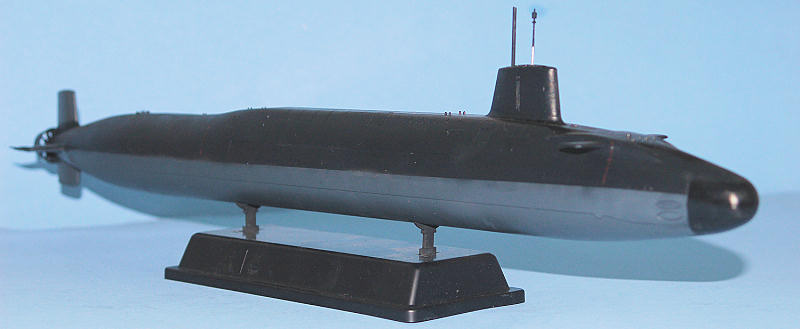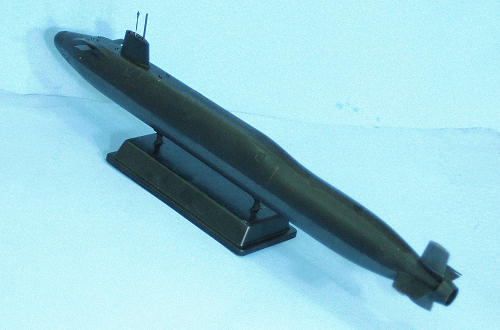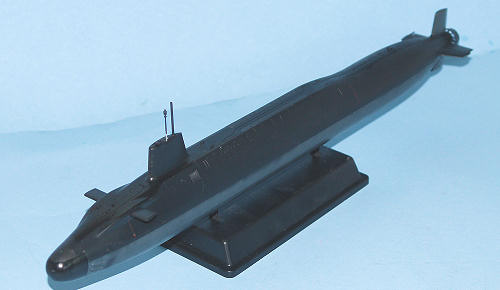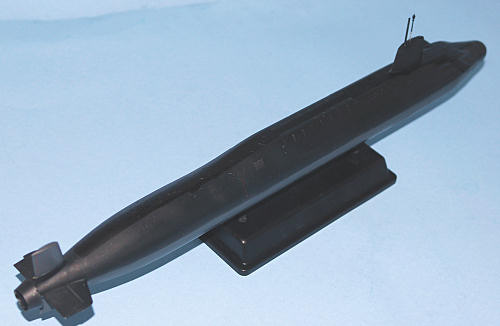
BossBronco 1/350 HMS Vanguard SSBN
| KIT #: | 5014 |
| PRICE: | $34.98 SRP |
| DECALS: | None |
| REVIEWER: | Tom Cleaver |
| NOTES: |

| HISTORY |
Introduced in 1994, the four “Vanguard” class SSBNs were the result of
the decision to replace the previous “Resolution” class SSBNs, armed with the
old Polaris SLBM with the Trident D-5. The class includes HMS Vanguard
(S28), commissioned in 1993; HMS Victorious (S29), commissioned in 1995;
HMS Vigilant (S30), commissioned in 1996; and HMS Vengeance (S31),
commissioned in 1999. All were built by Vickers Shipbuilding and Engineering
Ltd. at Barrow-in-Furness between 1986 and 1999, and are now based at HMS
Neptune), 25 miles west of Glasgow, Scotland.
 In 1998, all WE.177 free-fall nuclear bombs and all other nuclear weapons
were removed from the British Army, the Royal Air Force, and all surface ships
of the Royal Navy, with the result that the Vanguard/Trident SLBM system is the
sole nuclear weapon system for the UK. Each Vanguard carries 16 Trident-II D5
missiles, each equipped with eight MIRV warheads, with a yield of 100-120
kilotons.
In 1998, all WE.177 free-fall nuclear bombs and all other nuclear weapons
were removed from the British Army, the Royal Air Force, and all surface ships
of the Royal Navy, with the result that the Vanguard/Trident SLBM system is the
sole nuclear weapon system for the UK. Each Vanguard carries 16 Trident-II D5
missiles, each equipped with eight MIRV warheads, with a yield of 100-120
kilotons.
The ships were designed as unlimited-range nuclear powered ballistic
missile submarines, unlike the Resolution class which had been adapted
from the earlier Valiant class and American
HMS Vanguard arrived at Devonport Naval Base in February 2002, to
begin a two year refit including a new reactor core, which was completed in
January 2005. Following sea trials, which included test launching of Trident II
D5 ballistic missiles, the vessel has returned to the fleet.
The Vanguard’s nuclear powered propulsion system is based on the
second-generation Rolls-Royce  nerations
of
nerations
of
In September 2009, British Prime Minister Gordon Brown announced to the
UN General Assembly that the
| THE KIT |
Bronco Models announced this kit, the first British nuclear-powered
submarine to appear in injection-molded plastic, this past summer.
Previously, the only other 1/350 kit of a “Vanguard” class SSBN was the
resin kit from White Ensign Models. The kit has 30 parts in grey plastic, and a
base.
| CONSTRUCTION |
 As with most modern submarine models, and submarine models in general,
the kit is the essence of simplicity.
All the parts fit very well, and I only had to use filler along the seam
for the upper and lower hull halves.
As with most modern submarine models, and submarine models in general,
the kit is the essence of simplicity.
All the parts fit very well, and I only had to use filler along the seam
for the upper and lower hull halves.
The kit provides two of the missile hatches separate so they can be posed
open with a Trident missile installed.
I chose to close them up, which was the only difficult part of the
project, since I had to trim them to fit and then rescribe the area once they
were glued in position.
| COLORS & MARKINGS |
I followed the painting instructions in the kit.
The lower hull and the vertical rudders were painted with Tamiya “German
Grey,” while the upper hull was painted with Tamiya “NATO Black.”
The deck walkway area was masked and painted with Tamiya “Flat Black,”
while the bow was masked and painted with Tamiya “Semi-Gloss Black.”
I then gave the model an overall coat of Xtracrylix Flat Varnish and
applied the very simple decals, which are the displacement measurements.
| CONCLUSIONS |
 This is probably not a kit I would have bought had I seen it on the shelf
at the LHS, but that would have been my loss.
Modern submarines are the essence of modeling simplicity, but they can be
impressive when completed. A
measure of just how big one of these SSBNs is was demonstrated when I placed it
next to my 1/350 USS San Francisco heavy cruiser, which is only about an
inch and a half longer than this submarine.
For submarine modelers, and ship modelers in general, this is an
inexpensive kit (relatively speaking) that is accurate and nothing that can’t be
completed as a weekend project.
This is probably not a kit I would have bought had I seen it on the shelf
at the LHS, but that would have been my loss.
Modern submarines are the essence of modeling simplicity, but they can be
impressive when completed. A
measure of just how big one of these SSBNs is was demonstrated when I placed it
next to my 1/350 USS San Francisco heavy cruiser, which is only about an
inch and a half longer than this submarine.
For submarine modelers, and ship modelers in general, this is an
inexpensive kit (relatively speaking) that is accurate and nothing that can’t be
completed as a weekend project.
Thanks to Stevens International for the review copy.
September 2009
If you would like your product reviewed fairly and quickly, please contact me or see other details in the Note to Contributors.